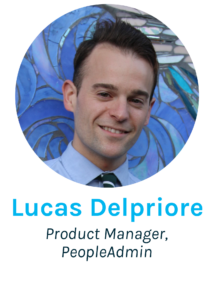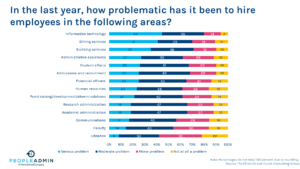How to Optimize Faculty Activity: Best Practices for Academic Leaders
Between managing teaching assignments, navigating promotion and tenure review, balancing faculty workloads, and tracking down course evaluations, academic affairs teams and academic administrators are kept busy constantly. Unfortunately, a lot of academic processes are manual and inefficient, adding administrative burden to everyone’s days and making things like true workload balance almost impossible. In our recent webinar, How to Optimize Faculty Activity: Best Practices for Academic Leaders, HigherEd experts broke down why efficient academic processes are more important than ever and shared some best practices for optimizing faculty activity. Check out some key takeaways below!
 The faculty landscape has changed
The faculty landscape has changed
Lucas Delpriore, PeopleAdmin Product Manager for faculty solutions, discussed the recent shift in the faculty retention and hiring landscape.
“According to research by the Chronicle of higher Education, the appeal of working in HigherEd has decreased since 2020 thanks to many factors, including the attraction of remote and hybrid work, which can be more difficult for colleges and universities to offer,” said Lucas. “The appeal of higher pay and more flexibility offered by the corporate world has become stronger, making it more difficult for higher education institutions to attract and retain talent.”
In a poll by the Chronicle, respondents indicated that for nearly every position, hiring has become problematic, whether moderately or seriously. This is a new challenge for HigherEd, where hiring has traditionally been relatively easy, with a large pipeline of candidates.
 Focus on retention
Focus on retention

Because of these hiring challenges, colleges and universities have a renewed focus on retention, employee engagement, upskilling and reskilling. Supporting faculty is especially important. Lucas recommends:
- In hiring materials, emphasize the benefits of working on a campus (including community, the chance to make a difference, and other benefits specific to your institutional mission)
- Give faculty more chance to articulate their interests and needs when it comes to courseload, research, and service opportunities
- Create engagement opportunities for both faculty and staff, including professional development opportunities to emphasize career growth
 Get the full picture of faculty workload
Get the full picture of faculty workload
Sharon Dormire, Ph.D., RN, the Associate Dean for Undergraduate Nursing at Texas A&M University, has been part of a big change in academic administrative processes at her institution. They now use Teaching Assignment Management System (TAMS) to optimize their course assignment process, and it’s made a huge difference not just with teaching assignments, but with faculty relationships.
“It completely changed the transparency. Faculty could see where the workload was. They could see the courses and could negotiate,” said Sharon. “Faculty had choices. TAMS handles the administrative side of service, committees, leadership, even research; all of that is defined as workload and everyone’s workload now reflects their reality. Issues of over and under assignment showed up—and now we can see them and fix them.”
Check out the webinar on demand for more!
For more best practices and insight about faculty workload and academic affairs administration, check out our webinar on-demand!
